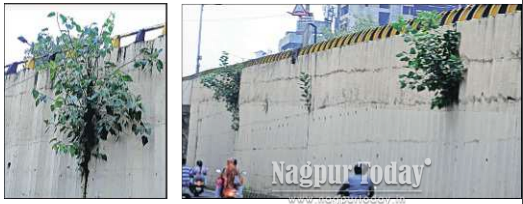Nagpur: At a time when Nagpur takes pride in being counted among the country’s fastest growing cities, one of its busiest flyovers tells a very different story, of neglect and administrative apathy.
The Sitabuldi Flyover, a key artery connecting the city’s central and southern stretches, is now under silent attack from nature itself. Large Peepal trees have started sprouting from its concrete walls, not weeds or saplings, but sturdy growths with notoriously invasive root systems.
The problem is visible at both ends of the flyover, near Sitabuldi Police Station and on the Rahate Colony T-point ramp. Experts warn that Peepal roots can penetrate deep into cement and steel, creating cracks that compromise structural strength. If allowed to grow unchecked, they could spell disaster for the bridge and the thousands of commuters who use it daily.
This latest warning sign only adds to the flyover’s troubled history. Designed without provisions for heavy vehicles, it has repeatedly been subjected to misuse and accidents owing to delayed or poorly enforced traffic restrictions. Civic agencies, despite multiple alerts, have failed to install adequate barriers or take preventive measures.
Urban planners note the irony: While global think-tanks such as Oxford Economics have hailed Nagpur as one of the world’s top ten fastest-growing cities, basic maintenance of critical infrastructure is ignored. “The growth of trees on a flyover wall is not just a cosmetic issue, it is a structural red flag,” said one senior engineer.
For commuters, the sight of green shoots breaking through grey concrete has become a worrying metaphor. Unless authorities step in swiftly to clear the vegetation and conduct a full structural audit, the city risks letting one of its most vital flyovers literally crack under neglect.
















